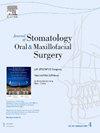Preoperative intramuscular botulinum Toxin-A to enhance postoperative outcomes in oral submucous fibrosis surgery: A randomized controlled trial
IF 2
3区 医学
Q2 DENTISTRY, ORAL SURGERY & MEDICINE
Journal of Stomatology Oral and Maxillofacial Surgery
Pub Date : 2025-10-01
DOI:10.1016/j.jormas.2025.102439
引用次数: 0
Abstract
Summary
The aim of this Randomized Controlled Trial (RCT) was to evaluate the pain relief and mouth opening achieved with preoperative injection of Botulinum Toxin-A (BTX-A) into bilateral temporalis and masseter muscles in patients with Oral Submucous Fibrosis (OSMF), following surgical intervention, compared to the control group. Additionally, the effectiveness of BTX-A in the uptake of the Buccal Fat Pad (BFP) graft and the patient satisfaction score were also studied.
Material and methods
Twenty patients with OSMF were randomly assigned to two groups (n = 10 each). Group A received BTX-A injections preoperatively, while Group B received normal Saline (NS) injections, which were followed by surgical intervention. All patients underwent fibrotomy followed by reconstruction using a Buccal Fat Pad (BFP) graft. The outcomes assessed were pain and mouth opening at 1 week, and at 1, 3, and 6 months postoperatively. Graft uptake and patient satisfaction were evaluated at the 3rd and 6th months, respectively. Pain was assessed using the Numeric Rating Scale (NRS), mouth Opening was measured using a stainless-steel ruler, graft uptake was evaluated clinically, and patient satisfaction score was recorded using a Likert Scale.
Results
A statistically significant reduction in mean pain score was seen at 1, 3, and 6 months postoperatively in the BTX-A group. Although an increased mouth opening was noted in the BTX-A group, the difference between the two groups was not statistically significant. There was a statistically significant difference between the mean patient satisfaction score of the BTX-A and NS groups at 6 months, in favour of the BTX-A group. Graft uptake was uneventful in both groups.
Conclusion
BTX-A appears to be a valuable adjunct to surgery and physiotherapy in the management of OSMF by enhancing postoperative comfort and outcomes.
术前肌内注射肉毒毒素A提高口腔黏膜下纤维化手术的术后预后:一项随机对照试验。
本随机对照试验(RCT)的目的是评估手术干预后口腔黏膜下纤维化(OSMF)患者术前向双侧颞肌和咬肌注射肉毒毒素a (BTX-A)所达到的疼痛缓解和口腔张开效果,并与对照组进行比较。此外,还研究了BTX-A对颊脂肪垫(BFP)移植物摄取的有效性和患者满意度评分。材料与方法:将20例OSMF患者随机分为两组(n = ,每组10例)。A组患者术前给予BTX-A注射,B组患者术后给予生理盐水(NS)注射。所有患者均行纤维切开术,然后用颊脂肪垫(BFP)移植物重建。评估结果为术后1周、1、3、6个月的疼痛和开口。分别在第3个月和第6个月评估移植物摄取和患者满意度。使用数字评定量表(NRS)评估疼痛,使用不锈钢尺测量开口,临床评估移植物摄取,并使用李克特量表记录患者满意度评分。结果:BTX-A组术后1、3、6个月的平均疼痛评分均有统计学意义的降低。虽然在BTX-A组中注意到开口增加,但两组之间的差异没有统计学意义。6个月时BTX-A组与NS组患者平均满意度评分差异有统计学意义,BTX-A组优于NS组。两组的移植物摄取均无明显变化。结论:BTX-A通过提高术后舒适度和预后,在OSMF的治疗中似乎是一种有价值的辅助手术和物理治疗。
本文章由计算机程序翻译,如有差异,请以英文原文为准。
求助全文
约1分钟内获得全文
求助全文
来源期刊

Journal of Stomatology Oral and Maxillofacial Surgery
Surgery, Dentistry, Oral Surgery and Medicine, Otorhinolaryngology and Facial Plastic Surgery
CiteScore
2.30
自引率
9.10%
发文量
0
审稿时长
23 days
 求助内容:
求助内容: 应助结果提醒方式:
应助结果提醒方式:


